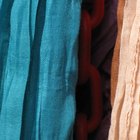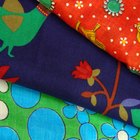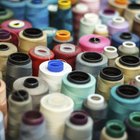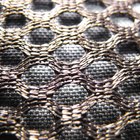
Jupiterimages/Goodshoot/Getty Images
Recognizing the difference between cashmere and viscose may be more difficult than it seems. Both fibers can be remarkably soft and are frequently used to make large shawls or wraps, called pashminas, as well as sweaters. Cashmere is significantly more expensive, more durable and warmer than viscose, so being able to tell the difference may help you to determine whether a garment is a steal or whether you're about to be a victim of retail confusion.
Cashmere
Cashmere is an animal fiber, produced by cashmere goats. Originally native to the Himalayas, a cashmere goat produces only a few ounces of cashmere each year -- and the goat only produces good-quality cashmere until around 4 or 5 years of age. The soft fiber is combed or sheared from the goat, cleaned and processed before being spun into thread for weaving or yarn for knitting. Cashmere is known for its softness and warmth, but given the labor-intensive production, it is consistently quite expensive.
Viscose
Viscose, called rayon in the United States, is a man-made fiber derived from cellulose or wood pulp. Production of viscose began around the end of the 19th century; however, it did not become common in clothing until the 1920s. Viscose is far more versatile than most animal fibers and can be made to resemble cotton, linen, wool -- or even cashmere.
Recognizing the Differences
While both viscose and cashmere can produce a very soft fabric, cashmere is quite matte, without any shine or sheen. As a natural fiber, it will pill with wear and may have a slight halo of fuzz around the threads. Viscose fibers have a notable sheen, particularly when examined in strong light. The fiber is unlikely to pill. In most cases, the garment should have a label with fiber content. Cashmere will be labeled "cashmere" -- and it will be spelled correctly.
Care
While cashmere and viscose may resemble one another, the appropriate care differs somewhat. Wash cashmere by hand in cool to lukewarm water with a mild detergent made for woolens. Roll in a towel to remove excess moisture and dry flat, or have cashmere dry cleaned by a reputable dry cleaner. Avoid hot water or excessive friction while laundering, to keep the fabric from shrinking or felting. For viscose, gently hand wash or machine wash on the gentle cycle, and avoid wringing. Viscose may rip or tear in hot water, so avoid the hot cycle on your washer and keep hand washing water lukewarm. Hang to dry or, if needed, iron while still damp, using a pressing cloth to prevent shine.
Related Articles

Microfiber vs. Cotton Clothes

Properties of Cashmere Yarn

Fake Vs. Real Pashmina

Can a Wool Coat Be Worn in the Rain?

How to Clean Mohair

Care of Mohair Fabric

What Is Arnel Vintage Material Fabric?

How to Care for Rayon and Spandex ...

The Care of Plisse Fabric

How to Stop Cashmere Itch

How to Avoid Stretching out Acrylic ...

Characteristics of Rayon Fabric

How to Stretch a Rayon Sweater

The Disadvantages of Rayon Fabric

Can You Hand Wash Silk That Says Dry ...

How to Wash Cotton Fabric

How to Clean Viscose Shawls

What Is the Difference Between Lycra ...

What Season to Wear Corduroys?

How to Protect Cashmere Scarves From ...
References
Writer Bio
With a master's degree in art history from the University of Missouri-Columbia, Michelle Powell-Smith has been writing professionally for more than a decade. An avid knitter and mother of four, she has written extensively on a wide variety of subjects, including education, test preparation, parenting, crafts and fashion.
Photo Credits
Jupiterimages/Goodshoot/Getty Images